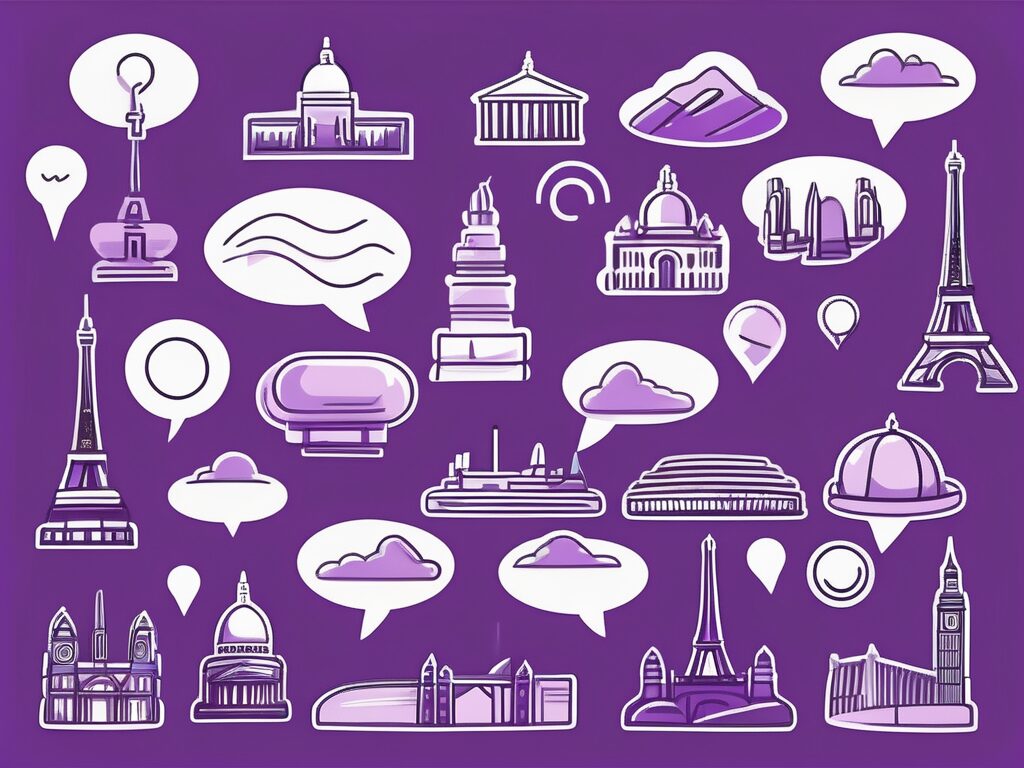Multilingual Chat
02 Feb 2024 By: Michael Kansky
Updated
Picture this: a world where language barriers simply vanish. That’s the heart of ‘Multilingual Chat’ in live chat services. It’s like a universal translator, ensuring smooth conversations across different languages. In today’s global village, this feature is crucial. It opens doors for businesses to connect with a wider audience. Bringing everyone a bit closer, one chat at a time.

Thanks to technological advancement, multilingual chat has come a long way. It’s now all about using cool tech and smart methods to translate messages on the fly. Making sure everyone can chat smoothly, no matter their native language. In this piece, we dive deep into what ‘Multilingual Chat’ really means for live chat services.
Definition of Multilingual Chat
At its core, multilingual support is all about breaking down language barriers. It’s a cool feature in live chat platforms that translates messages on the spot. Letting people who speak different languages chat without a hitch. The magic happens in real-time. Making conversations flow smoothly. It should work between folks from all over, no matter their language.
‘Multilingual Chat’ and ‘Real-Time Translation’ might sound the same. This is when we’re talking about live chat services. But there’s a slight difference worth noting. In every multilingual support, you get translations as you type. But, not all real-time translation is for multilingual support. ‘Multilingual Chat’ is a special shout-out to those chat platforms that really get the party started by supporting a bunch of languages.
Components of Multilingual Chat
A multilingual live chat system is built on a few essential parts. The chat interface, the translation engine, and a language database full of canned responses. Picture the chat interface as the front desk where users drop off their messages. The translation engine is like the behind-the-scenes wizard. Magically turning those messages from one language into another. And the language database? It’s the treasure chest of words and phrases the translation engine digs into to get the job done.
Elevate your live chat game! Explore 40 Essential Canned Response Examples for Live Chat Agents now!
These pieces all team up to make chatting across languages smooth and effortless. Here’s how it goes down: you type a message in your own language into the chat box. Then, the translation engine kicks into gear. Using the treasure trove of language data to switch your message into the recipient’s language. Just like that, your translated message pops up on the other person’s screen, ready for them to read.
Types of Multilingual Chat
Chat in different languages comes in a few flavors, each suited to different needs. The big players are machine translation, human translation, and hybrid translation. Machine translation leans on AI algorithms to whip up translations in real time. Human translation, as you might guess, relies on actual people to translate messages. Then there’s hybrid translation, which mixes machine smarts with human touch. Ensuring translations that are both quick and nuanced.
Boost your communication! Discover the power of Real-Time Messaging today!
Each style of multilingual chat comes with its own set of pros and cons. Machine translation is your go-to for quick and large-scale translating needs. Though it might not always catch the subtle context or the nuances a human translator would. On the flip side, human translation nails the accuracy and gets the context right. But can’t quite keep up with the pace or handle the load like its machine counterpart. Hybrid translation is the middle ground. It aims to blend the best of both worlds. The efficiency of machine translation and the precision of human translation.
Importance of Multilingual Chat in Live Chat Services
The value of multilingual live chat services is huge. In our global village, businesses regularly serve customers from many language backgrounds. Multilingual chat helps these companies. It lets them talk smoothly with their customers, no matter the language they speak. This boosts customer happiness and broadens the company’s horizons.
Plus, multilingual support ramps up customer service efficiency. With real-time translation, companies don’t have to hire a team of multilingual agents. This slashes costs and simplifies the whole process of offering customer support in several languages.
Benefits of Multilingual Chat
Multilingual chat, whether it’s used reactively or proactively in live chat services, comes with some great perks. A big one is boosting customer satisfaction. When customers can chat in their own language, they feel more at home and valued. This personal touch can make them happier and more likely to stick around.
Enhance engagement! Unlock the benefits of Proactive Chat now!
Another cool advantage of multilingual chat is that it broadens your business’s horizon. By speaking multiple languages, you can connect with a bigger crowd, potentially boosting sales and profits. Also, it gives you an edge in the global marketplace. It lets you reach customers your rivals might miss due to language hurdles.
Challenges of Multilingual Chat
Even with its many perks, rolling out chat in different languages service isn’t a walk in the park. Getting translations right is a big hurdle. Sure, AI has gotten a lot smarter, but it still trips over some phrases and idioms. These slip-ups can cause mix-ups and misunderstandings, putting a dent in customer happiness.
Tackling multilingual chat also means dealing with its cost and complexity. The price tag and the hassle can vary a lot. Depending on how many languages you’re juggling and whether you’re using machine, human, or hybrid translation. Businesses have to think long and hard about these aspects. Consider these before using multilingual chat for your live chat services.
Trending Now
Heather Shoemaker, the mind behind Language I/O, casts a discerning eye on the burgeoning field of generative AI translation. Urging a blend of optimism and caution. As AI and machine learning redefine the boundaries of natural language processing. The promise of seamless multilingual communication glimmers on the horizon. Yet, this promise has challenges. They are about accuracy, context, and the reliability of AI. These issues remain thorny. The landscape of AI-driven translation is rapidly expanding. Evidenced by the booming global language translation software market. However, the path forward is fraught with potential pitfalls. From the nuances of language that AI struggles to grasp to ethical concerns surrounding bias and privacy.
Despite these hurdles. AI translation is evolving. It has the potential to revolutionize how businesses engage across language divides. Offering a more efficient alternative to traditional multilingual staffing. But as we navigate this promising yet precarious terrain. Shoemaker’s insights serve as a vital reminder. The journey towards effective and ethical AI translation requires meticulous attention. To the technology’s limitations and a steadfast commitment to addressing them. In this era of technological marvels, the goal remains clear. Unlocking AI’s potential to connect us across languages. While safeguarding the principles of accuracy, security, and inclusivity.
Future of Multilingual Chat
The future of multilingual chat looks promising. Thanks to leaps in AI and machine learning that are set to make translations even sharper and faster. Plus, as businesses keep reaching out across the globe, the call for multilingual chat is only going to grow. This push is bound to spark more innovation and enhancements in the field.
One promising direction for growth is blending multilingual chat with cool tech. This tech includes voice recognition and virtual reality. Imagine chat experiences that are not just interactive but totally immersive. Plus, with AI getting smarter, we’re looking at translations that grasp nuances and context better than ever. This means multilingual chat could get even more accurate and effective.
Impact of AI on Multilingual Chat
AI has already transformed multilingual chat. Thanks to machine learning algorithms that translate messages instantly with impressive accuracy. But we’re just scratching the surface. The future of AI holds even more promise, with the potential for translations that not only hit the mark on accuracy but also nail the context. This could take the power of multilingual chat to a whole new level.
Furthermore, AI could also take chatting to a more personal level. Imagine AI learning your language likes and dislikes. And then automatically translating messages into your preferred language. This could make chatting feel more tailored and cozy, just for you.
Integration of Multilingual Chat with Other Technologies
Mixing multilingual chat with other cool tech is a big opportunity for growth. Take voice recognition, for example. Pairing it with multilingual chat could let us have voice-driven chats in multiple languages. Making the whole experience more engaging and interactive.
Similarly, adding multilingual chat to virtual reality could open up amazing chat adventures. This fusion could create super immersive and lifelike chat sessions. Ramping up customer happiness and involvement to new heights.
“If you talk to a man in a language he understands, that goes to his head. If you talk to him in his own language, that goes to his heart.”
— Nelson Mandela
Conclusion
Multilingual chat is an essential piece of the live chat service puzzle. Bridging the gap between users who speak different tongues. It’s built on a few crucial parts. A chat interface where messages are typed. A translation engine that switches languages. And a language database that holds all the linguistic goodies. There’s a variety of multilingual chat types, each fitting different needs like a glove.
The value of multilingual chat can’t be hyped enough. It not only boosts customer happiness and broadens business horizons. But it also streamlines customer service. Sure, there are hurdles to clear, but the road ahead for multilingual chat is bright. Thanks to AI getting smarter and the potential to merge with other cutting-edge tech. We’re on the cusp of even cooler innovations and upgrades in this space.
Tapping into this innovative world, our virtual assistants and 24/7 customer service team are here to take your back-office tasks and customer support off your hands, freeing you up to focus on the core of your business. Our bilingual agents are ready to boost your efficiency. Talk to us today and experience the difference with HelpSquad BPO.
FAQ
What is multilingual chat, and why is it important for live chat services?
Multilingual chat lets customers communicate in their own language without barriers. With the help of a live translator and real-time translation engines, businesses can support users from anywhere in the world. It’s one of the best tools for multilingual live chat because it boosts accessibility, increases customer satisfaction, and helps companies reach a global audience with ease.
How do the best tools for multilingual live chat actually work?
The best tools for multilingual live chat combine a chat interface, AI-driven translation engines, and language databases to convert messages instantly. A built-in live translator interprets the message on the fly, switching it into the customer’s preferred language within seconds. This setup allows seamless communication. Even if both sides speak completely different languages.
Do businesses need multilingual agents if they use a live translator?
Not necessarily. With a reliable live translator, companies can offer support in many languages without hiring multilingual staff. The best tools for multilingual live chat use machine learning to translate instantly, often at a lower cost than building a multilingual team. Human translators can still be used for complex cases, but AI handles most day-to-day conversations efficiently.
What challenges should companies expect when implementing multilingual chat?
The biggest challenge is translation accuracy. Even the best tools for multilingual live chat can struggle with idioms, slang, or cultural nuances. A live translator may misinterpret tone or context, leading to confusion. Businesses should also consider cost, technical setup, and the number of languages they plan to support. A hybrid system, AI plus human oversight, often works best.
How do we ensure the information in this multilingual chat guide is accurate and trustworthy?
All insights in this article come from real-world multilingual support practices, research on AI translation, and industry standards for the best tools for multilingual live chat. The explanations reflect how modern live translator systems work in customer service environments and include guidance shaped by current trends in machine translation, customer experience, and multilingual communication technology.


